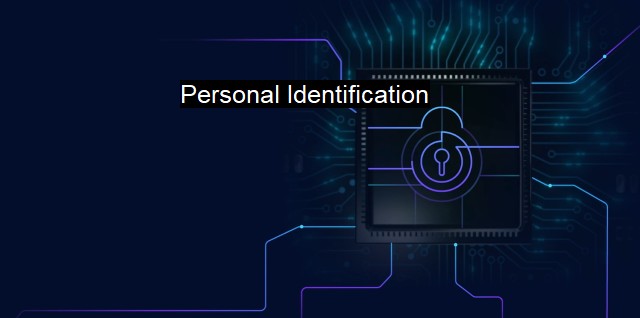What is Personal Identification?
The Importance of Personal Identification in Cybersecurity: Preventing Unauthorized Access, Ensuring Data Privacy and Protection, and Curbing Insider Threats.
What is "Personal Identification"?
Personal identification refers to the process of confirming an individual's identity. In other words, it's the way by which an individual is identified and verified as belonging to a specific group or organization. The importance of personal identification in the context of cybersecurity cannot be overstated. It is key to ensuring the right people have authority over a system, and that those without permission are kept out.
One reason why personal identification is essential in cybersecurity is because it helps prevent unauthorized access to systems and data. When individuals access such systems and data without verification, it can potenty cause severe damage, both at an individual and organizational level. Unauthorized access to an organization's systems and data is the leading cause of data breaches and other security threats to the system. Personal identification ensures that access to systems and data is restricted only to the right persons, hence fostering security.
Another reason why personal identification is vital in cybersecurity is that it plays a crucial role in data privacy and protection. By verifying individuals' identities, it's possible to track what actions each took within a system over some time. When such records exist, it's possible to assign accountability to anyone who generally violates data use policies within a company.
The process of personal identification is also crucial for identifying and curbing insider threats. Whenever people have access to particular systems, they can unintentionally or deliberately cause significant harm. Insider threats are risky as attackers have lengthier time prepared and may go unnoticed easily. By had a steel grip with personal identification measures, intervention can quickly occur to deter or thwart attempts.
Personal identification can be done through various measures, including authentication and authorization techniques, passwords and tokens, biometric methods (e.g., fingerprints, retina scans, and facial recognition), and firewall rules. These methods help to verify the individual's identity and restrict access to temporary or experienced users. With the growing sophistication amongst cyber-criminals could jeopardize compromised these methods. Great implies on modern-day personal identification may emerge as Zero Trust and multifactor authentication techniques.
An exceptional measure for intending to ensuring personal identification is by investing in antivirus programs and cybersecurity lessons regularly. Antivirus is a vital tool in preventing threats to individuals or an entire organization. These techniques sniff and detect suspected hacks or attacks, extract abnormal activity, and prevent harmful behavior cum protections to ultimately prevent these activity.
the context of personal identification related to cybersecurity must include strong organizational data policies that creates an atmosphere and timely monitoring against cyber-attacks that could identify a threat to data, making it easy while actual interception is possible.
Personal identification is a crucial process that is vital in diverse sectors of the societal affairs where security breaches aggrandize quickly every passing by. In its adaptations, cybersecurity systems must circumspect its urgency both for defending data privacy, safeguard insider threats, and providing a spearhead against perpetrators. While techniques range including passwords and biometrics among others from small scale individuals alone, or larger sectors like the companies, entire credit must be given to cybersecurity protocols for heightening the effects of personal identification by adopting modern-day approaches willingly.

Personal Identification FAQs
What is personal identification?
Personal identification refers to the process of verifying an individual's identity through the use of credentials or personal information. It is an essential component of cybersecurity and antivirus systems to prevent unauthorized access to personal or sensitive data.What kind of personal identification methods are commonly used in cybersecurity and antivirus systems?
Commonly used personal identification methods in cybersecurity and antivirus systems include passwords, biometrics (such as fingerprint, facial recognition, or iris scans), two-factor authentication, and security questions.Why is personal identification important in cybersecurity and antivirus systems?
Personal identification is crucial in cybersecurity and antivirus systems because it helps to prevent unauthorized access to sensitive data, resources, and systems. It also helps to ensure that only authorized individuals have access to certain information or functions, thereby reducing the risk of data breaches, cyber fraud, or other malicious activities.What are some best practices for personal identification in cybersecurity and antivirus systems?
Some best practices for personal identification in cybersecurity and antivirus systems include using strong, unique passwords or passphrases, enabling two-factor authentication or multi-factor authentication, avoiding public Wi-Fi, staying cautious of phishing scams, and keeping antivirus and cybersecurity software up-to-date. Additionally, users should avoid sharing their personal information, such as social security numbers or credit card information, unless it is absolutely necessary and with trusted, reputable sources. External Resources
| | A | | | B | | | C | | | D | | | E | | | F | | | G | | | H | | | I | | | J | | | K | | | L | | | M | |
| | N | | | O | | | P | | | Q | | | R | | | S | | | T | | | U | | | V | | | W | | | X | | | Y | | | Z | |
| | 1 | | | 2 | | | 3 | | | 4 | | | 7 | | | 8 | | |||||||